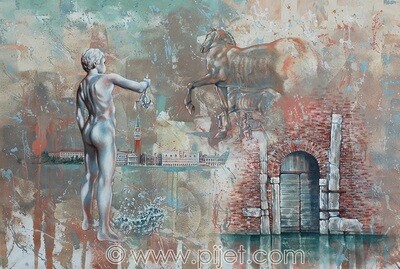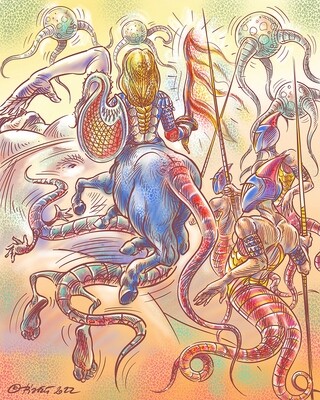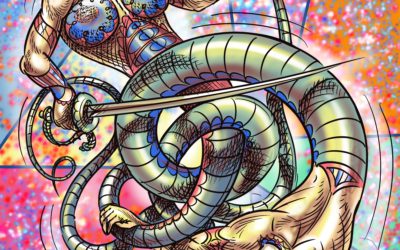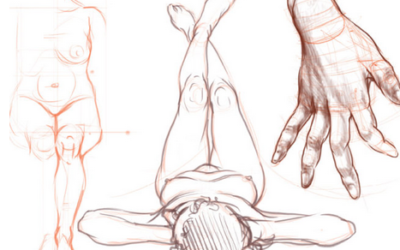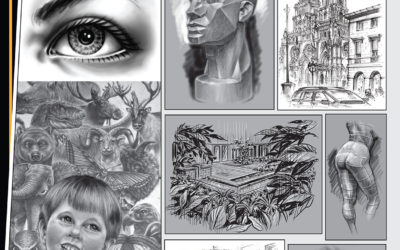“Mirror: A Psychological Door to the Otherness of Self.”
Mirror as a charming and mysterious object begun to be used by humans approximately from the beginning of six thousands years BC. The first traces of the object used as mirror were made from the obsidian,[1] which were found in Anatolia.[2] Besides obsidian another materials were used for production of these reflecting reality commodities.[3] The mirror as we know it today appeared in the first part of nineteenth century.[4] Human’s curiosity evolved around the mirror’s particular abilities to reflect anything what was placed in front of it. This mirror’s specific quality helped Alberti[5] to establish the principles of perspective. At the early stage of mirror’s popularity the fact of owning one was considered as a luxury and indicated also the social status of the owner. Due to the mirrors’ intriguing capacities to imitate reality, people have developed the pleasure in discovering secret parts of their own bodies, which they would not be able to see otherwise. The taste of personal appearance and representation has developed, what was in particular advantage to the feminine part of the society. The mirror quickly became a utility of the first necessity as a means of personal assurance of oneself. With the mirror’s growing popularity the possibilities of psychological consequences of looking at oneself reflected image inspired scholars to do the studies of its potential effects and explore these issues psychoanalytically:[6] in particular, the various theories concerning the allocation of libido named Narcissism.[7]
The first and the most known example of the disastrous consequences of over exaggerated admiration of oneself mirrored reflection was Narcissus (see fig. 1). His story was propagated in various literary sources going back as far as the Greek mythology. There are three different variants of the Narcissus’s tale.[8] However, the Ovid’s’[9] version of Narcissus story described in his Roman epic “Metamorphosis” is probably the most popularized account of this unfortunate adventure. In Ovid’s tale Narcissus is the son of the Nymph Liriope and the river god Cephisus. The baby from the beginning was of extreme beauty. When his mother wandering about her son’s future went to see Teiresias,[10] he told her that Narcissus would live as long as he would never know himself. When Narcissus was sixteen, the nymph Echo falls in love with him. Narcissus rejected her love. Heartbroken nymph suffers an enormous pain and she slowly disappears to the point that finally only her voice stays alive. The goddess Nemesis[11] touched by her tragedy decided to punish Narcissus making him falling in love with his own reflection in the pool. Enable to fulfill his desires Narcissus finally dies. It is sad but deeply meaningful myth. Based on this story the meaning of the word Narcissism entered to the Western history as an overstated admiration of self, leading to the egocentric behavior of an individual.
Narcissus’s misfortune inspired artists since the early stages of the Western cultural development. Writers,[12] poets, sculptors, and painters nourished their creativities on Narcissus tragedy. The various interpretations of this original story are not always exact. The painterly interpretations of this myth including the Acadian surroundings were the most successfully depicted by Nicolas Poussin (see fig. 2) and John William Waterhouse (see fig. 3). They are typically literary interpretations of this tale. Caravaggio’s[13] version is completely different from the previous two artists, because the painter focused on the psychological aspect of it and more personal approach to it. In order to emphasize this, Caravaggio put on Narcissus a dress from his own epoch and not the mythological one. Caravaggio was not the only one who found out that there is much more in this story than just a fascinating myth. The tale is interesting because it is touching the psychological aspects related to the human perception of reflected reality. The painters as Van Eyck[14] and Velázquez[15] treated the psychological aspect of mirror reflection in particular to them respective way. Van Eyck in his painting titled “Portrait of Giovanni Arnolfini and his Wife” (see fig. 4), intricate the space of the canvas by depicting the curved mirror in the central middle space of his artwork. The mirror’s particular optics reflect the entire space visible from its position on the wall including the backsides of the portrayed couple and the people present in front of them including the artist himself.[16] The reason for the presence of the curved mirror might be the artist’s desire to create three-dimensional space on flat canvas, what would permit him to join intellectually the entire space visible from all sides. It is also possible that the artist’s Narcissistic psychology tempted him to depict his own reflection in the mirror. Velázquez in his painting titled “Las Meninas or The Family of Philip IV” (see fig. 5) aborts the aspects of psychological space created by the presence of the mirror in the similar way as Van Eyck did, but reverses the importance of the artist’s presence in the picture to highlight the Narcissist individuality. The presence of the flat mirror in the middle of the painting with almost perfectly depicted faces of the Queen and the King complete the three-dimensionality of the space visible through the Royal eyes. It suggests that Velazquez’s underlines his own importance as a painter in the eyes of Queen and King.
The perception of the psychological space created by the mirror’s reflection was always intriguing to many artists and each of them had a particular way to deal with it. These issues have been explored a lot in the art of self-portraiture. The self-portraiture art in its essence is nothing more than a psychological reflection of not always objective image of the artist and his personality. Any kind of portraiture projects artist’s Narcissist attitude. Furthermore, any kind of portraiture is nothing else than reflection of the Narcissist idealistic perception of the portrayed self. It is interesting to see how the artists perceive their own reflection in the mirror and transform it on the canvas. In just few examples it is possible to review how various artists deal with it. It is evident in Victor Brauner’s[17] psychological premonitory[18] self-portrait that the artist’s focus was mainly on his obsessive self (see fig. 6). In the same spirit of Freudian psychic territory is the self-portrait of Francis Bacon[19] (see fig. 7), who as he said about himself always hated his personal visage what to some degree is visible on his artwork. However, the“Baconian” aesthetics of the mastery of his brush proof the opposite and expose his Narcissist affection of self. Jean-Pierre Reynard’s[20] self-portrait (see fig. 8 ) reflects the artist’s obsession with the grid. The grid over his face refers to the way his projected reflection is framed by the social perception of the artistic creative sensibility. The Erik Bulatov’s[21] self-portrait (see fig. 9) combines the artist’s duplicated individuality framed by the context of the social limitations reflected in the infinity of the mirror’s space. It is a psychoanalytic point of view of the artist’s self-embraced place by the space allowed to his artistic liberty.
The question of the reflection projected by the other unreachable materiality of the mirror infinite space was probably aborted in the most interesting way by the Surrealism movement. The Surrealistic art tried to mirror the unconsciousness of the dreamed fantasies intellectuality. For Surrealists the psychoanalytic perception of the reflected reality was filtered through their visionary mind inspiring the efforts to apprehend and capture its essence in their artworks. Painters such as Salvador Dali,[22] Paul Delvaux,[23] and René Magritte[24] were preoccupied by the psychoanalytic vision of thought reflected in the mirror of their intellectual vision. Dali’s depiction of “Metamorphosis of Narcissus” (see fig. 10) takes the viewer to his own Narcissist space exteriorized by him on the canvas. It is a very different interpretation of Ovid’s myth in comparison with other paintings reviewed earlier. Here the traditional myth faces the intellectual contemporary reflections: the first is in the water and the second on the right side of the painting. Dali depicted his own perception of the Freud’s “Anti cathexis”[25] through his “Dalistic” personal vision of it. His dreamed hallucinations mirror its-own inner creative complexity.
Paul Delvaux is exposing his “Simulacrum”[26] world overwhelmed by the erotic fantasies in artist’s chosen works (see fig. 11, 12, 13). From each portrayed characters emanates the Narcissist desire to escape to the realities of the beautiful desirable hallucinations offered by the infinite opening of the mirror’s surface. Delvaux’s paintings reflect the artist’s personal psychological visual autobiography exteriorized through the actions of the feminine characters. Delvaux through his visual linguistics shows the mirror as an object able to transfer the mental state of anyone to the other realities. The personages dream about different realities through the surface of the mirror. It could be seen as a “Hegelian”[27] dialog between the model that owns the mirror and the mirror itself, but in the reversed order where the mirror owns the model and the model takes the place of the mirror as an object.[28]
René Magritte through the image of the mirror as the subject of his allegoric voyages depicts in his artworks various concepts in order to express the state of his mind in relation to the other self. In the image “The Reproduction” (see fig. 14) Magritte depicts his interior battle against his Narcissist temptations by depicting the mirrors incapability to reproduce the perfect reflection of the silhouette standing in front of it. In each of his paintings Magritte poses questions but he does not offer any answers. It is the viewer who reads the hidden messages accordingly to its mental ability. The painting “False Mirror” (see fig. 15) represents the artist view of the outside world from the inside of his eye. It is yet another reflection of the artist’s self. Magritte created in this piece an interior dialogue with the exterior world through the instrument of the vision. This time the artist refers to the allegoric mirror and his abilities to look at the outside world through his own psychological perspective depicting the interior space of the eye. It is possible to assume that he took his inspiration from the Velazquez’s artwork “Las Meninas or The Family of Philip IV.” In the artwork “Dangerous Liaisons” (see fig. 16) Magritte created a perfect representation of the Narcissist self-sufficiency. The mirror protective reflection of the female body suggests that we all carry within ourselves a certain amount of a psychological luggage of the Narcissist tendencies. Magritte by using the philosophical imagery provokes a dialog of an intellectual exchange by exposing publicly the fragmented unity of his visualized thoughts. The summary of his hybrid compositions collected from the logical visual contradictions engages the viewer to reflect on the surrounding realities of his own. Magritte in his works is playing with the irrationalities of the reflected space by implying different order accordingly to his own-mirrored perception of his physical existence.
The apparition of photography changed significantly the problem of inconstancy of he produced mirrored reflection. From now on any reflection of mirrored space can be documented and looked at it at any time. The picture can be printed and carried as a very personal reflection of intimate moments. One of the first masters who exposed these mysterious abilities of the mirror was Eugène Atget.[29] He had a great sensibility to capture the pictures with the stories to read from them. The picture “Ambassade d’Autriche, 57 rue de Varenne” (see fig. 17), gives an impression of the mirror reflection of the hotel room. It captures the invisible history of that piece and its sublime ambiance of the physical presence of the previous visitors in that room. This picture has the content for psychoanalytic studies of the interior space reflected through the mirror in the room. The two divided parts of the chamber by the mirror are connected by the chimney and the reflected other part of the room suggests the presence of a couple, which after exchange of the energy of their libidos left the room going each of them in different directions. Atget through his image tells the story remaining hidden behind his camera visible on the left side of the mirror reflection. The fact that he decided to show himself in the picture and not to take another shot from different angle in order to avoid of being visible proves to some point his personal Narcissist touch in it. The picture “Shop Window: Tailor Dummies” (see fig. 18), Atget captured the essence of human existence in the industrialized world of the big cities. The human mannequins in the window, with the reflected in the glass city architecture, suggest an allegorical automatism of the Modern life, which is taken over by the fever of the commodities consumption. Atget exposes in his pictures his own admiration or even love of the objects them-selves. He is exploring the psychological otherness of the reflected spaces. From his pictures he projects a poetic psychology of the photographed area. He perceives the reflected spaces through the Freudian psycho analytics without probably knowing it. Atget was using his “camera lucida”[30] to create as Barthes putted nicely together in his book[31] referring to his thoughts about photography: “little mythologies” of human lives. Mirror and photography share common similarities. Both of them reflect the reality of the spaces and objects. However, they do it with significant differences. The reflections in the mirror are never permanent exposed on constant changes, in contrary the photographic image frames the moments of the reflected subject preserving a visual proof of its one time existence.
The mirror aspect of fluid permanence was explored often by the cinematographic productions. The fact that the movie camera reflects and registers in the same time the presence and the past, which could be reviewed indefinitely as a simulated truth captured on the celluloid pages, opened another possibilities to the artistic creativities. Especially when talking about the Avant-Gardism in cinema during the Surrealist period of thirties and forties. At the beginning of nineteen thirty-two individuals were competing between each other permanent leaders of the Surrealist cinema: the best known is Jean Cocteau[32] and Luis Bunuel.[33]
Jean Cocteau and Luis Bunuel received each one million dollar from the Viscount Charles de Noailles in order to freely explore their creative talents respectively. Jean Cocteau realized the movie “Le Sang d’un Poète” (see fig. 19) and Luis Bunuel made “L’Age d’Or.” The film “Le Sang d’un Poète” is loaded with a variety of symbolic references to the human existence. The first image shows a chimney build from the bricks as an allegoric representation of manhood achievements in every meaning of this word including the aspect of “libido.” The story of the film describes the life of an artist trying in his studio to create a masterpiece, which would help him to secure his artistic carrier, a dream shared by many artists. His mind is overtaken by his desires transferring him from the rational to the irrational world of his imagination. He draws a portrait of a woman with simple lines and when he finished to draw the lips he realized that they look as if they are alive. Scared by his own irrationality, he tries to erase the leaps with his hand. The lips would not to go and finally they transferred themselves on the artist’s hand. The lips became the part of artist’s body. The beauty of the lips provokes the artist to kiss them and putting his tongue inside of his own hand. This extremely erotic scene is beautifully elaborated interpretation of Narcissus myth. Cocteau transferred in this scene the genius of his poetic imagery. He as well refers to his own Narcissism. The scene reflects his mirrored passionate interiority. The kiss of the lips on his hand releases the artist’s emotional tension. He sat on the chair and falls asleep. When he awakes he realizes that he is in the company of a sculpture without lips. By trying to detach the lips from his hand he touches the sculpture’s head and the lips from his hand moved on the bust’s face. Instantly the sculpture started to speak saying to him: “Is not it stupid to strain the statues from their mundane sleep?”[34] Here Cocteau makes another reference to our hidden desires and anxieties to expose them to the public. It is a symbolic representation of the fear to be radicalized and wrongly perceived by our gestures posed in the public. The next scene of the movie begins with the artist awaken in the empty room without windows where instead of doors there is a big mirror. Artist started to look nervously for the way to escape from this strange place. The only apparent way of getting out is the mirror. He touches the mirror and realized that its surface is liquid. He puts his hands inside the mirror in order to assure his next move. Finally he decides to jump in. On the other side of the mirror is an empty space. He swims through in the air as if in the water arriving to the corridor with many doors. Cocteau in the scene with the mirror refers to the way the mystery of the mirror is perceived by humans as yet another space to explore. As many artists have tried to explore the mirror’s illusory space before in their respective approaches, Cocteau takes his chance to propose his own poetic version of it.
He invites the viewer to the abyss of the mirror’s space, which he opens to the public playing the role of an intellectual guide. Cocteau visualized the complexity of the artistic creativity with the various rooms in the corridor where the artist is looking at each of them through the keyhole in the doors. The Surrealistic poetry of his visions leads the viewer through the rest of his Avant-Garde epopee. The movie finishes as it started, with the brick chimney but this time the chimney falls down in ruins. Everything has to die and give a chance to a new beginning. It concerns the artists too. Cocteau tried in his movie to show allegorically the mental specifics of creative process. It is visual depiction of thought rambling through the artist’s brain cells.
Cocteau in his movie explores the theme of the mirror through the labyrinth of his own interior fantasies. It is Cocteau’s own biographical story. Through the character of an artist he expose his own artistic Narcissist ” libido” of his intellectual mind.
Through the reviewed few samples of various artistic creativities inspired by the void irrational space of the mirror, it is possible to see how important place in the human life this commodity object always has been. The mirror psychologically attracts our attention because it reflects the “Other” of us and gives us the impression to have a “perfect” twin. However, it is important to remember that it is just an illusion.
It is appropriate to conclude with the translation of the phrase written by Seneque:[35] “The mirrors were invented for better knowledge and understanding of self.”
[3] Polished copper mirrors in Mesopotamia from 4 000 BC and Egypt from 3 000 BC, polished stone mirrors in central and South America from 2 000 BC, polished bronze mirrors in China from 2 000 BC. Glass mirrors coated with metal were produced in today’s Lebanon in the first century AC. In Italy glass mirrors coated with the gold fakes were crafted in the first century AC. From 11th century clear glass mirrors were crafted in Moorish Spain. In early Renaissance in Europe glass mirrors coated with tin-mercury amalgam were produced.
[5] Leon Battista Alberti (1404–1472) was an Italian author, artist, and architect, author of the “Traité de la Peinture.”
[6] Sigmund Freud (1856 -1939), was an Austrian psychiatrist who founded the psychoanalytic school of psychology. Jacques-Marie-Émile Lacan ( 1901-1981), was a French psychoanalyst and psychiatrist.
[7] This process was described in 1899 by Paul Näcke (1851-1913), German psychiatrist and criminologist. He introduced to the psychology the concept of Narcissism.
[8] Two various interpretations of this myth exists in Greek sources. One is told by Parthenius of Nicaea in Bithynia a Greek grammarian and poet, and the other by Pausanias a Greek traveller and geographer of the 2nd century AD.
[9] Publius Ovidius Naso (43 BC–AD 17 or 18), Roman poet known as Ovid who wrote about love, seduction, and mythological transformation.
[13] Michelangelo Merisi da Caravaggio (1571-1610), Italian Baroque painter working in Rome, Naples, Malta and Sicily.
[14] Jan van Eyck or Johannes de Eyck (1395-1441), Early Netherlandish painter from Bruges. Considered one of the best Northern European painters of the 15th century.
[15] Diego Rodríguez de Silva y Velázquez (1599-1660), Spanish Baroque painter in the court of King Philip IV.
[16] it is still debatable if the painter intention was to paint his figure as a witness of the marriage ceremony or just something else.
[22] Salvador Domingo Felipe Jacinto Dalí i Domènech1st Marquis of Púbol (1904-1989), Spanish Catalan surrealist painter.
[25] Battle between cathexis and anti-cathexis, Cathexis, is a form of energy converted in psychic energy, which through different filters reaches the conscious mind.
[28] The original phrase comes from the article of Edith Kurzweil “Jacques Lacan: French Freud” on the page 426 “Hegelian dialectic between Master and Slave.” For the purpose of this essay the sentence was completely modifies and only the idea was appropriated.
Bibliography:
Cohen , Milton A. “Cummings and Freud,” American Literature, Vol. 55, No. 4 (Dec., 1983): 591-610.
Freud, Sigmunt. 1. Introductory Lectures on Psychoanalysis. Pelican Books, London, 1991.
Gilson, René. Jean Cocteau Cinéaste. Lherminier Editions des Quatre-Vents, Paris, 1988.
Kurzweil, Edith. “Jacques Lacan: French Freud.” Theory and Society, Vol. 10, No. 3 (May, 1981): 419-438.
Melchior-Bonnet, Sabine. Histoire du Mirroire. Editions Imago, Paris, 1994.
Pinoteau, Claude. Derrière la Caméra avec Jean Cocteau. Horizon Illimité, Paris.
Weiss, Peter. Cinéma d’Avant-garde. L’Arche, Paris, 1989.
Zdebik, Jakub. ARTH-383 Course Pack, Art and Philosophy. Concordia University, Faculty of Fine Arts, 2009.

